wheel bolt torque NISSAN X-TRAIL 2003 Electronic Repair Manual
[x] Cancel search | Manufacturer: NISSAN, Model Year: 2003, Model line: X-TRAIL, Model: NISSAN X-TRAIL 2003Pages: 3066, PDF Size: 51.47 MB
Page 465 of 3066
![NISSAN X-TRAIL 2003 Electronic Repair Manual REMOVAL AND INSTALLATION
AT-459
[ALL]
D
E
F
G
H
I
J
K
L
MA
B
AT
12. Remove center member, engine insulator and engine mounting
bracket.
lTighten center member fixing bolts to specified torque, Refer
t NISSAN X-TRAIL 2003 Electronic Repair Manual REMOVAL AND INSTALLATION
AT-459
[ALL]
D
E
F
G
H
I
J
K
L
MA
B
AT
12. Remove center member, engine insulator and engine mounting
bracket.
lTighten center member fixing bolts to specified torque, Refer
t](/img/5/57402/w960_57402-464.png)
REMOVAL AND INSTALLATION
AT-459
[ALL]
D
E
F
G
H
I
J
K
L
MA
B
AT
12. Remove center member, engine insulator and engine mounting
bracket.
lTighten center member fixing bolts to specified torque, Refer
toEM-61, "
ENGINE ASSEMBLY".
13. Remove suspension member. Refer toFSU-12, "
FRONT SUS-
PENSION MEMBER".
14. Remove dust cover from converter housing.
Rotate crankshaft to gain access to securing bolts.
15. Remove securing bolts between drive plate and torque con-
verter. when crank shaft rotates, turn to right at the front side of
engine.
16. Support engine with a jack.
17. Remove bolts fixing transaxle to engine.
18. Lower transaxle while supporting it with a jack.
InstallationECS004ND
1. Check drive plate runout.
CAUTION:
Do not allow any magnetic materials to contact the ring
gear teeth.
lIf this runout is out of allowance, replace drive plate with ring
gear.
2. When connecting torque converter to transaxle, measure dis-
tance “A” to be certain that they are correctly assembled.
SCIA0794E
AAT259A
Maximum allowable runout :
Refer to EM-´´, “FLYWHEEL/DRIVE PLATE RUNOUT”.
SAT977H
Distance “A”: 19 mm (0.626 in) or more
SAT573D
Page 845 of 3066
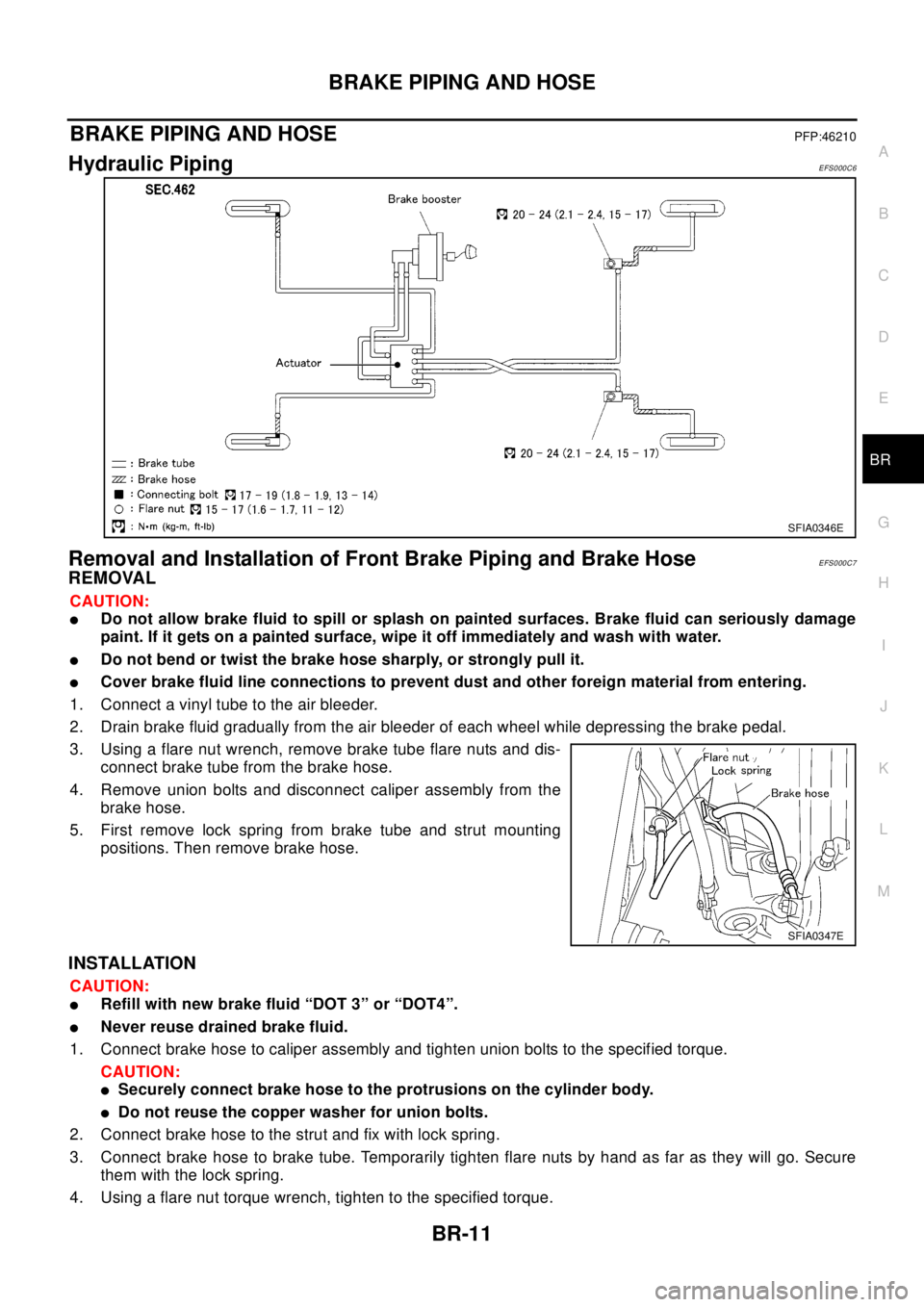
BRAKE PIPING AND HOSE
BR-11
C
D
E
G
H
I
J
K
L
MA
B
BR
BRAKE PIPING AND HOSEPFP:46210
Hydraulic PipingEFS000C6
Removal and Installation of Front Brake Piping and Brake HoseEFS000C7
REMOVAL
CAUTION:
lDo not allow brake fluid to spill or splash on painted surfaces. Brake fluid can seriously damage
paint. If it gets on a painted surface, wipe it off immediately and wash with water.
lDo not bend or twist the brake hose sharply, or strongly pull it.
lCover brake fluid line connections to prevent dust and other foreign material from entering.
1. Connect a vinyl tube to the air bleeder.
2. Drain brake fluid gradually from the air bleeder of each wheel while depressing the brake pedal.
3. Using a flare nut wrench, remove brake tube flare nuts and dis-
connect brake tube from the brake hose.
4. Remove union bolts and disconnect caliper assembly from the
brake hose.
5. First remove lock spring from brake tube and strut mounting
positions. Then remove brake hose.
INSTALLATION
CAUTION:
lRefill with new brake fluid “DOT 3” or “DOT4”.
lNever reuse drained brake fluid.
1. Connect brake hose to caliper assembly and tighten union bolts to the specified torque.
CAUTION:
lSecurely connect brake hose to the protrusions on the cylinder body.
lDo not reuse the copper washer for union bolts.
2. Connect brake hose to the strut and fix with lock spring.
3. Connect brake hose to brake tube. Temporarily tighten flare nuts by hand as far as they will go. Secure
them with the lock spring.
4. Using a flare nut torque wrench, tighten to the specified torque.
SFIA0346E
SFIA0347E
Page 846 of 3066
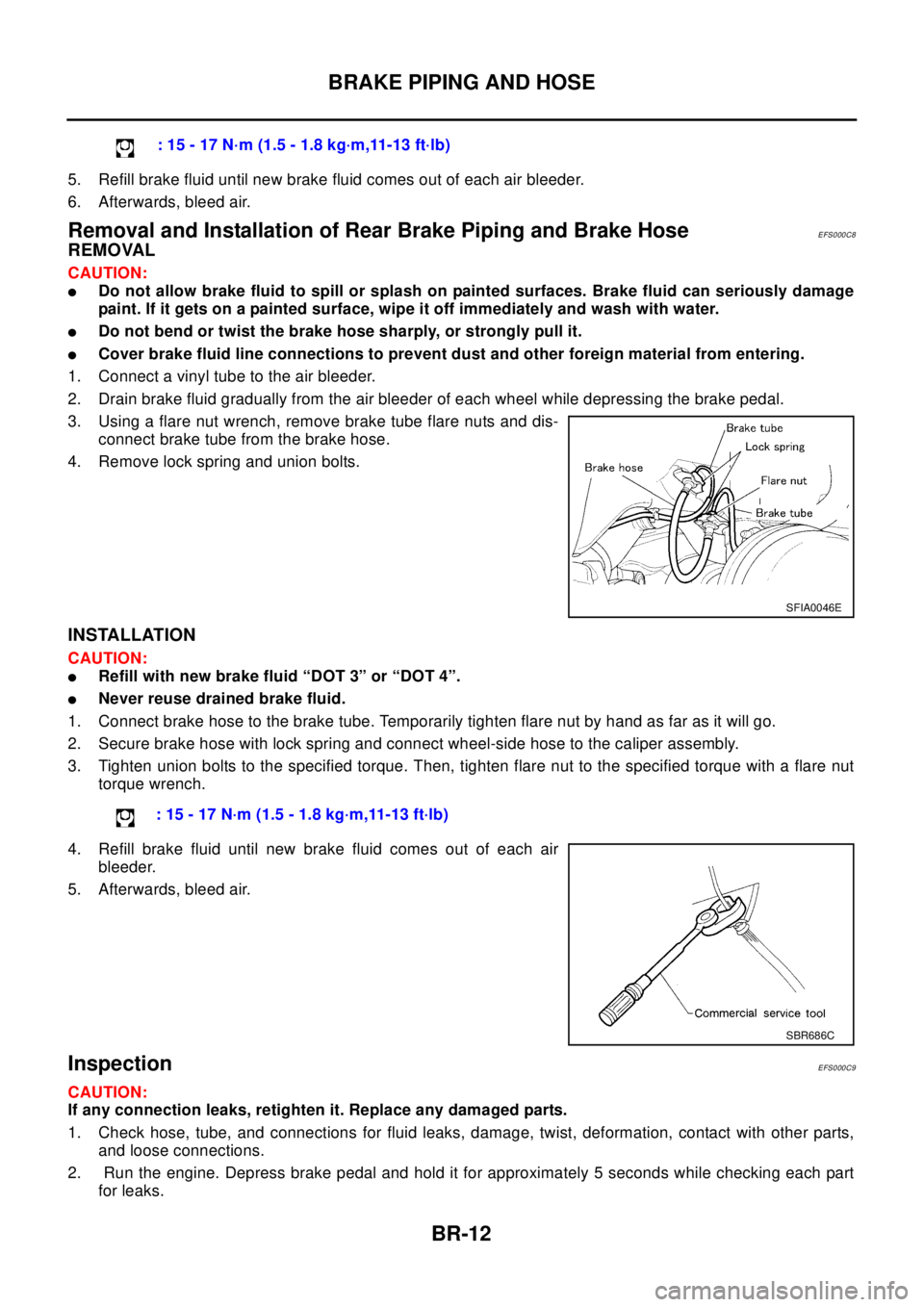
BR-12
BRAKE PIPING AND HOSE
5. Refill brake fluid until new brake fluid comes out of each air bleeder.
6. Afterwards, bleed air.
Removal and Installation of Rear Brake Piping and Brake HoseEFS000C8
REMOVAL
CAUTION:
lDo not allow brake fluid to spill or splash on painted surfaces. Brake fluid can seriously damage
paint. If it gets on a painted surface, wipe it off immediately and wash with water.
lDo not bend or twist the brake hose sharply, or strongly pull it.
lCover brake fluid line connections to prevent dust and other foreign material from entering.
1. Connect a vinyl tube to the air bleeder.
2. Drain brake fluid gradually from the air bleeder of each wheel while depressing the brake pedal.
3. Using a flare nut wrench, remove brake tube flare nuts and dis-
connect brake tube from the brake hose.
4. Remove lock spring and union bolts.
INSTALLATION
CAUTION:
lRefill with new brake fluid “DOT 3” or “DOT 4”.
lNever reuse drained brake fluid.
1. Connect brake hose to the brake tube. Temporarily tighten flare nut by hand as far as it will go.
2. Secure brake hose with lock spring and connect wheel-side hose to the caliper assembly.
3. Tighten union bolts to the specified torque. Then, tighten flare nut to the specified torque with a flare nut
torque wrench.
4. Refill brake fluid until new brake fluid comes out of each air
bleeder.
5. Afterwards, bleed air.
InspectionEFS000C9
CAUTION:
If any connection leaks, retighten it. Replace any damaged parts.
1. Check hose, tube, and connections for fluid leaks, damage, twist, deformation, contact with other parts,
and loose connections.
2. Run the engine. Depress brake pedal and hold it for approximately 5 seconds while checking each part
for leaks.:15-17N·m(1.5-1.8kg·m,11-13ft·lb)
SFIA0046E
: 15 - 17 N·m (1.5 - 1.8 kg·m,11-13 ft·lb)
SBR686C
Page 855 of 3066
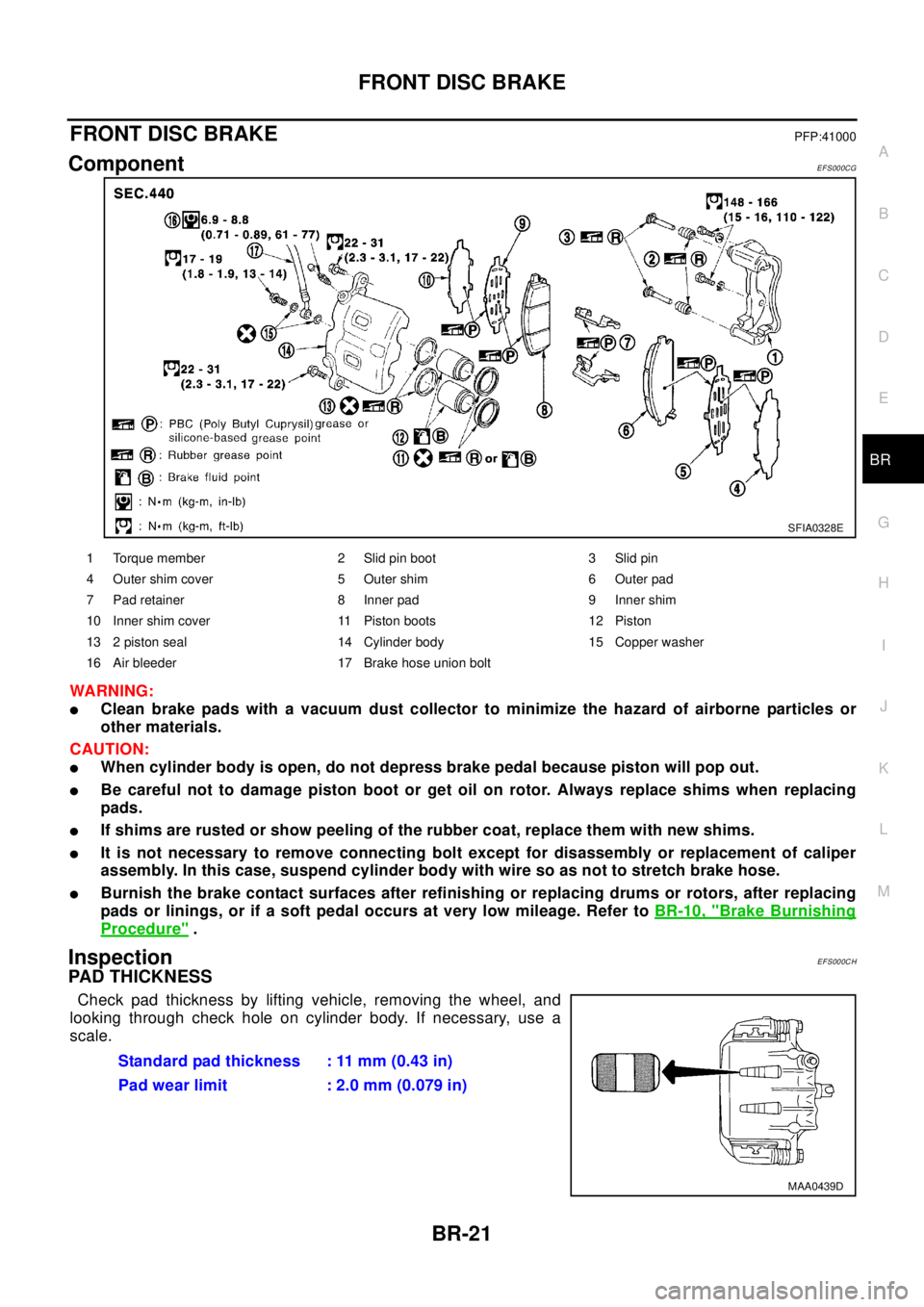
FRONT DISC BRAKE
BR-21
C
D
E
G
H
I
J
K
L
MA
B
BR
FRONT DISC BRAKEPFP:41000
ComponentEFS000CG
WA RN ING:
lClean brake pads with a vacuum dust collector to minimize the hazard of airborne particles or
other materials.
CAUTION:
lWhen cylinder body is open, do not depress brake pedal because piston will pop out.
lBe careful not to damage piston boot or get oil on rotor. Always replace shims when replacing
pads.
lIf shims are rusted or show peeling of the rubber coat, replace them with new shims.
lIt is not necessary to remove connecting bolt except for disassembly or replacement of caliper
assembly. In this case, suspend cylinder body with wire so as not to stretch brake hose.
lBurnish the brake contact surfaces after refinishing or replacing drums or rotors, after replacing
pads or linings, or if a soft pedal occurs at very low mileage. Refer toBR-10, "
Brake Burnishing
Procedure".
InspectionEFS000CH
PAD THICKNESS
Check pad thickness by lifting vehicle, removing the wheel, and
looking through check hole on cylinder body. If necessary, use a
scale.
SFIA0328E
1 Torque member 2 Slid pin boot 3 Slid pin
4 Outer shim cover 5 Outer shim 6 Outer pad
7 Pad retainer 8 Inner pad 9 Inner shim
10 Inner shim cover 11 Piston boots 12 Piston
13 2 piston seal 14 Cylinder body 15 Copper washer
16 Air bleeder 17 Brake hose union bolt
Standard pad thickness : 11 mm (0.43 in)
Pad wear limit : 2.0 mm (0.079 in)
MAA0439D
Page 858 of 3066
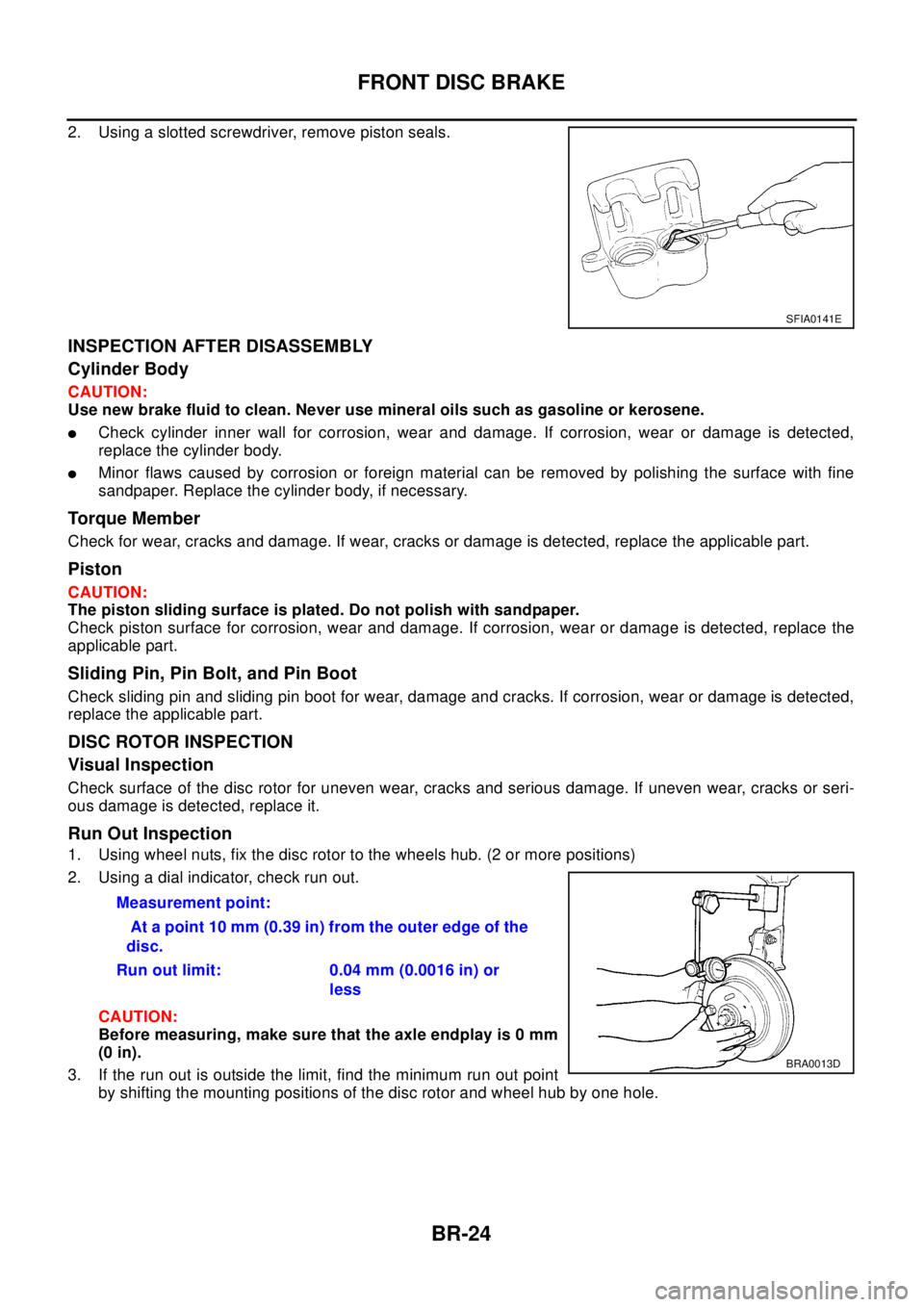
BR-24
FRONT DISC BRAKE
2. Using a slotted screwdriver, remove piston seals.
INSPECTION AFTER DISASSEMBLY
Cylinder Body
CAUTION:
Use new brake fluid to clean. Never use mineral oils such as gasoline or kerosene.
lCheck cylinder inner wall for corrosion, wear and damage. If corrosion, wear or damage is detected,
replace the cylinder body.
lMinor flaws caused by corrosion or foreign material can be removed by polishing the surface with fine
sandpaper. Replace the cylinder body, if necessary.
Torque Member
Check for wear, cracks and damage. If wear, cracks or damage is detected, replace the applicable part.
Piston
CAUTION:
The piston sliding surface is plated. Do not polish with sandpaper.
Check piston surface for corrosion, wear and damage. If corrosion, wear or damage is detected, replace the
applicable part.
Sliding Pin, Pin Bolt, and Pin Boot
Check sliding pin and sliding pin boot for wear, damage and cracks. If corrosion, wear or damage is detected,
replace the applicable part.
DISC ROTOR INSPECTION
Visual Inspection
Check surface of the disc rotor for uneven wear, cracks and serious damage. If uneven wear, cracks or seri-
ous damage is detected, replace it.
Run Out Inspection
1. Using wheel nuts, fix the disc rotor to the wheels hub. (2 or more positions)
2. Using a dial indicator, check run out.
CAUTION:
Before measuring, make sure that the axle endplay is 0 mm
(0 in).
3. If the run out is outside the limit, find the minimum run out point
by shifting the mounting positions of the disc rotor and wheel hub by one hole.
SFIA0141E
Measurement point:
At a point 10 mm (0.39 in) from the outer edge of the
disc.
Run out limit: 0.04 mm (0.0016 in) or
less
BRA0013D
Page 861 of 3066
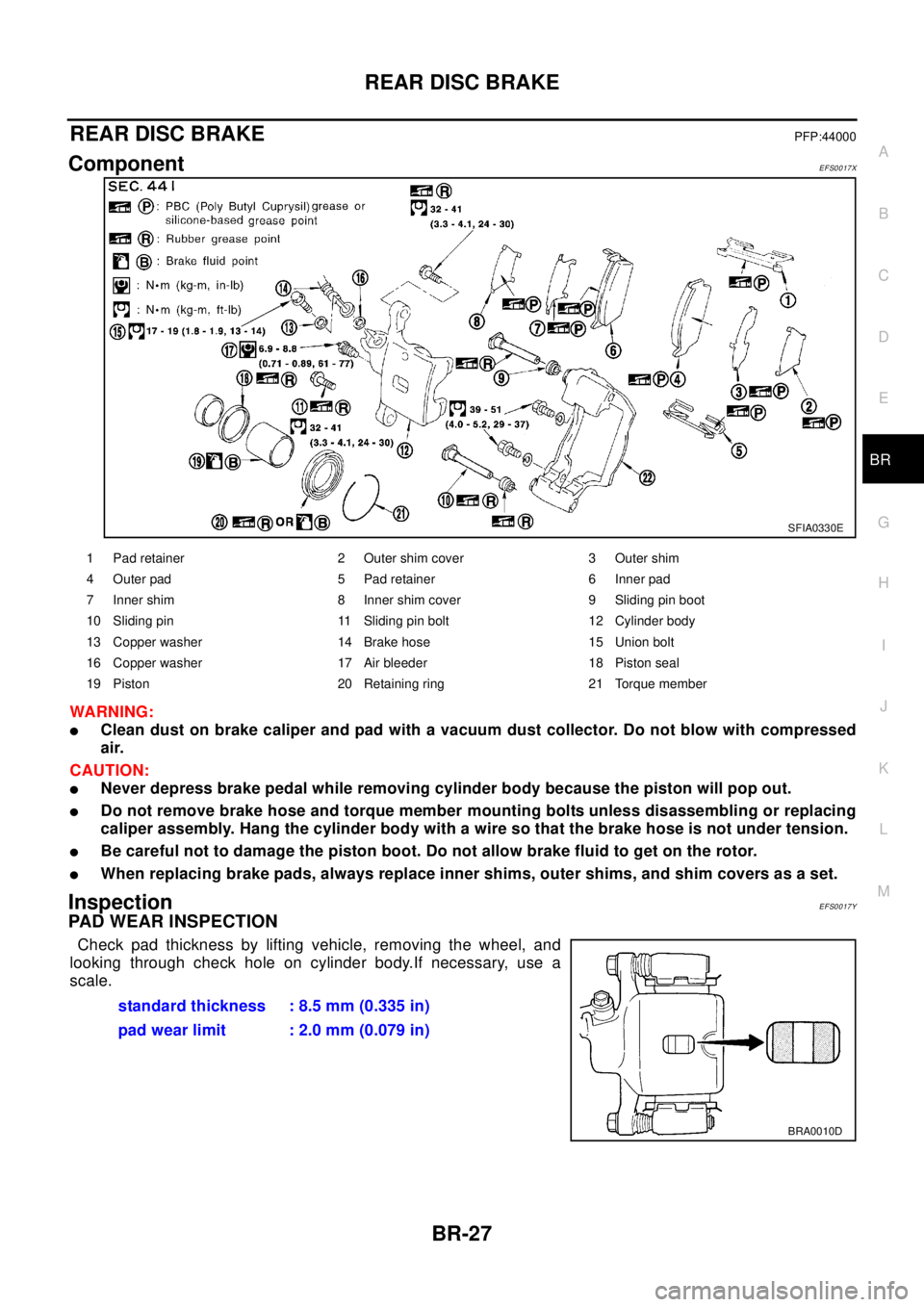
REAR DISC BRAKE
BR-27
C
D
E
G
H
I
J
K
L
MA
B
BR
REAR DISC BRAKEPFP:44000
ComponentEFS0017X
WA RN ING:
lClean dust on brake caliper and pad with a vacuum dust collector. Do not blow with compressed
air.
CAUTION:
lNever depress brake pedal while removing cylinder body because the piston will pop out.
lDo not remove brake hose and torque member mounting bolts unless disassembling or replacing
caliper assembly. Hang the cylinder body with a wire so that the brake hose is not under tension.
lBe careful not to damage the piston boot. Do not allow brake fluid to get on the rotor.
lWhen replacing brake pads, always replace inner shims, outer shims, and shim covers as a set.
InspectionEFS0017Y
PAD WEAR INSPECTION
Check pad thickness by lifting vehicle, removing the wheel, and
looking through check hole on cylinder body.If necessary, use a
scale.
SFIA0330E
1 Pad retainer 2 Outer shim cover 3 Outer shim
4 Outer pad 5 Pad retainer 6 Inner pad
7 Inner shim 8 Inner shim cover 9 Sliding pin boot
10 Sliding pin 11 Sliding pin bolt 12 Cylinder body
13 Copper washer 14 Brake hose 15 Union bolt
16 Copper washer 17 Air bleeder 18 Piston seal
19 Piston 20 Retaining ring 21 Torque member
standard thickness : 8.5 mm (0.335 in)
pad wear limit : 2.0 mm (0.079 in)
BRA0010D
Page 864 of 3066
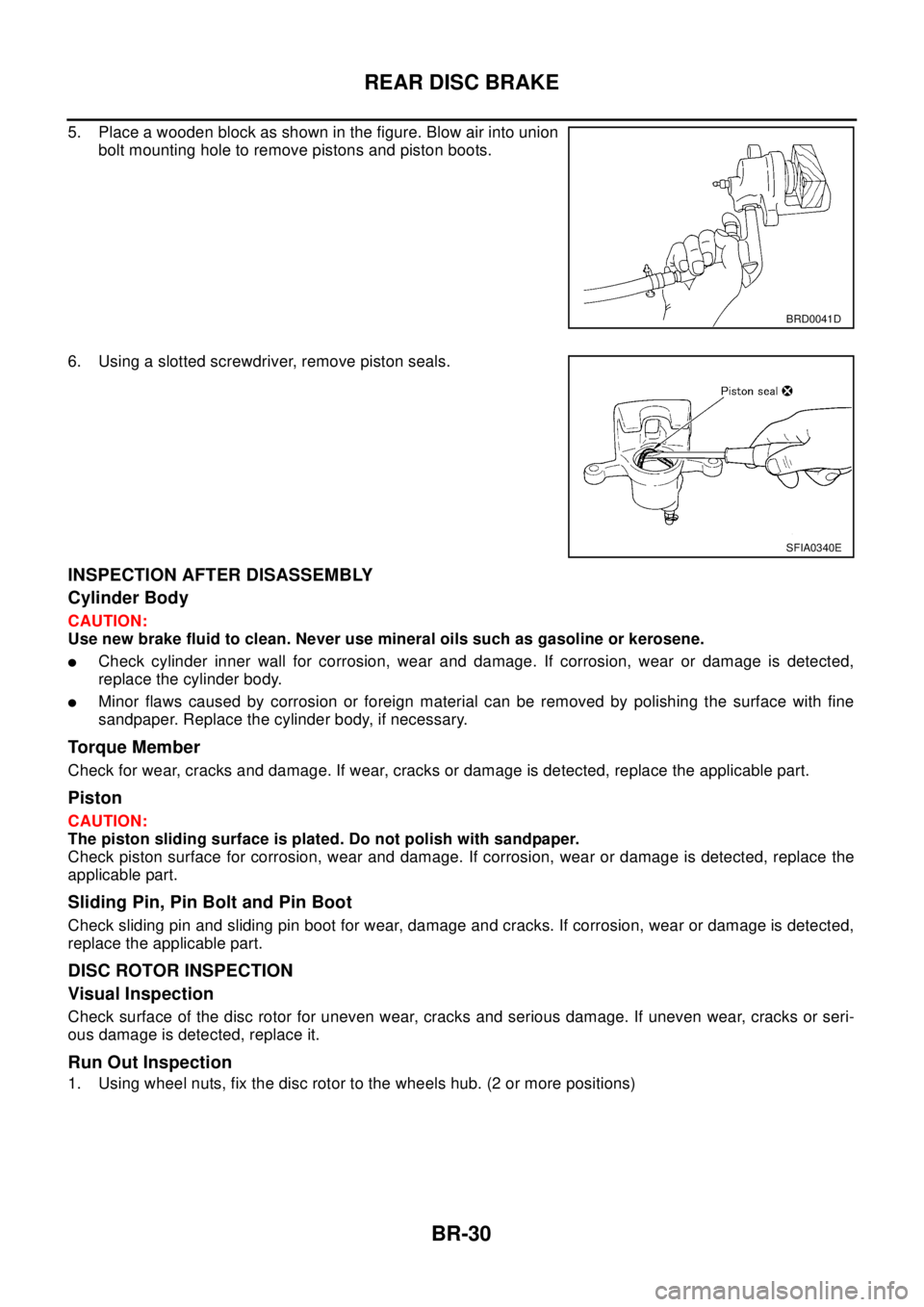
BR-30
REAR DISC BRAKE
5. Place a wooden block as shown in the figure. Blow air into union
bolt mounting hole to remove pistons and piston boots.
6. Using a slotted screwdriver, remove piston seals.
INSPECTION AFTER DISASSEMBLY
Cylinder Body
CAUTION:
Use new brake fluid to clean. Never use mineral oils such as gasoline or kerosene.
lCheck cylinder inner wall for corrosion, wear and damage. If corrosion, wear or damage is detected,
replace the cylinder body.
lMinor flaws caused by corrosion or foreign material can be removed by polishing the surface with fine
sandpaper. Replace the cylinder body, if necessary.
Torque Member
Check for wear, cracks and damage. If wear, cracks or damage is detected, replace the applicable part.
Piston
CAUTION:
The piston sliding surface is plated. Do not polish with sandpaper.
Check piston surface for corrosion, wear and damage. If corrosion, wear or damage is detected, replace the
applicable part.
Sliding Pin, Pin Bolt and Pin Boot
Check sliding pin and sliding pin boot for wear, damage and cracks. If corrosion, wear or damage is detected,
replace the applicable part.
DISC ROTOR INSPECTION
Visual Inspection
Check surface of the disc rotor for uneven wear, cracks and serious damage. If uneven wear, cracks or seri-
ous damage is detected, replace it.
Run Out Inspection
1. Using wheel nuts, fix the disc rotor to the wheels hub. (2 or more positions)
BRD0041D
SFIA0340E
Page 916 of 3066
![NISSAN X-TRAIL 2003 Electronic Repair Manual BRC-48
[4WD/ABS]
WHEEL SENSORS
WHEEL SENSORS
PFP:47910
Removal and InstallationEFS001C1
CAUTION:
lBe careful not to damage sensor edge and rotor tooth. Before removing front or rear wheel hub,
remove NISSAN X-TRAIL 2003 Electronic Repair Manual BRC-48
[4WD/ABS]
WHEEL SENSORS
WHEEL SENSORS
PFP:47910
Removal and InstallationEFS001C1
CAUTION:
lBe careful not to damage sensor edge and rotor tooth. Before removing front or rear wheel hub,
remove](/img/5/57402/w960_57402-915.png)
BRC-48
[4WD/ABS]
WHEEL SENSORS
WHEEL SENSORS
PFP:47910
Removal and InstallationEFS001C1
CAUTION:
lBe careful not to damage sensor edge and rotor tooth. Before removing front or rear wheel hub,
remove wheel speed sensor to avoid sensor wiring damage. Otherwise, sensor may be deacti-
vated.
lWhen removing sensor, avoid rotating it as much as possible. Do not forcibly pull sensor harness.
lWhen installing, check sensor pick-up and mounting hole for foreign material such as iron chips.
Check no foreign material has been caught in sensor rotor. Remove any foreign material found.
Tighten mounting bolts and nuts to the specified torque.
SFIA0042E
Page 987 of 3066
![NISSAN X-TRAIL 2003 Electronic Repair Manual WHEEL SPEED SENSORS
BRC-119
[ESP/TCS/ABS]
C
D
E
G
H
I
J
K
L
MA
B
BRC
WHEEL SPEED SENSORSPFP:47910
Removal and InstallationEFS001CD
CAUTION:
lBe careful not to damage sensor edge and rotor tooth. Befor NISSAN X-TRAIL 2003 Electronic Repair Manual WHEEL SPEED SENSORS
BRC-119
[ESP/TCS/ABS]
C
D
E
G
H
I
J
K
L
MA
B
BRC
WHEEL SPEED SENSORSPFP:47910
Removal and InstallationEFS001CD
CAUTION:
lBe careful not to damage sensor edge and rotor tooth. Befor](/img/5/57402/w960_57402-986.png)
WHEEL SPEED SENSORS
BRC-119
[ESP/TCS/ABS]
C
D
E
G
H
I
J
K
L
MA
B
BRC
WHEEL SPEED SENSORSPFP:47910
Removal and InstallationEFS001CD
CAUTION:
lBe careful not to damage sensor edge and rotor tooth. Before removing front or rear wheel hub,
remove wheel speed sensor to avoid sensor wiring damage. Otherwise, sensor may be deacti-
vated.
lWhen removing sensor, avoid rotating it as much as possible. Do not forcibly pull sensor harness.
lWhen installing, check sensor pick-up and mounting hole for foreign material such as iron chips.
Check no foreign material has been caught in sensor rotor. Remove any foreign material found.
Tighten mounting bolts and nuts to the specified torque.
SFIA0042E
Page 1008 of 3066
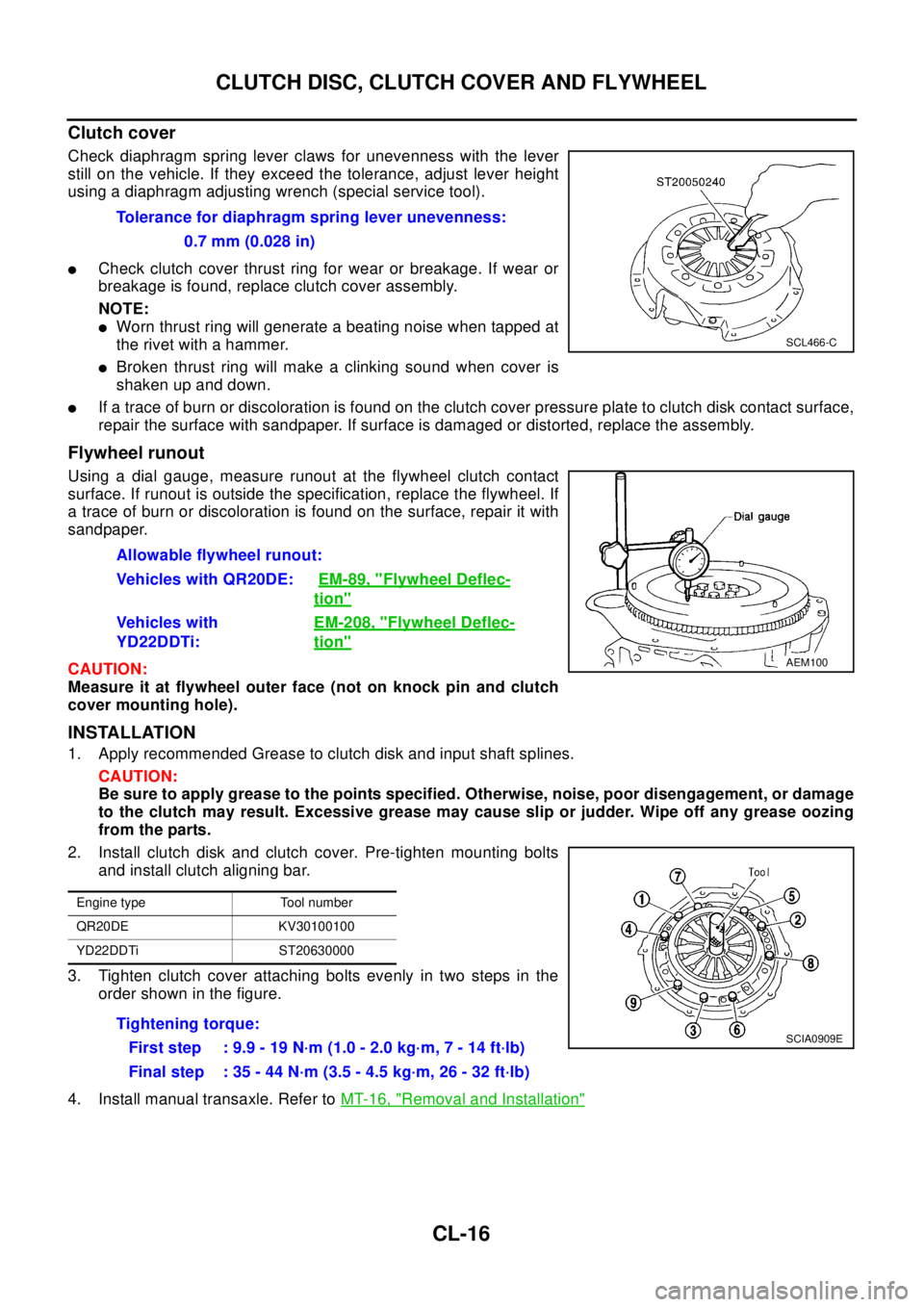
CL-16
CLUTCH DISC, CLUTCH COVER AND FLYWHEEL
Clutch cover
Check diaphragm spring lever claws for unevenness with the lever
still on the vehicle. If they exceed the tolerance, adjust lever height
using a diaphragm adjusting wrench (special service tool).
lCheck clutch cover thrust ring for wear or breakage. If wear or
breakage is found, replace clutch cover assembly.
NOTE:
lWorn thrust ring will generate a beating noise when tapped at
therivetwithahammer.
lBroken thrust ring will make a clinking sound when cover is
shaken up and down.
lIf a trace of burn or discoloration is found on the clutch cover pressure plate to clutch disk contact surface,
repair the surface with sandpaper. If surface is damaged or distorted, replace the assembly.
Flywheel runout
Using a dial gauge, measure runout at the flywheel clutch contact
surface. If runout is outside the specification, replace the flywheel. If
a trace of burn or discoloration is found on the surface, repair it with
sandpaper.
CAUTION:
Measure it at flywheel outer face (not on knock pin and clutch
cover mounting hole).
INSTALLATION
1. Apply recommended Grease to clutch disk and input shaft splines.
CAUTION:
Be sure to apply grease to the points specified. Otherwise, noise, poor disengagement, or damage
to the clutch may result. Excessive grease may cause slip or judder. Wipe off any grease oozing
from the parts.
2. Install clutch disk and clutch cover. Pre-tighten mounting bolts
and install clutch aligning bar.
3. Tighten clutch cover attaching bolts evenly in two steps in the
order shown in the figure.
4. Install manual transaxle. Refer toMT-16, "
Removal and Installation"
Tolerance for diaphragm spring lever unevenness:
0.7 mm (0.028 in)
SCL466-C
Allowable flywheel runout:
Vehicles with QR20DE:EM-89, "
Flywheel Deflec-
tion"
Vehicles with
YD22DDTi:EM-208, "Flywheel Deflec-
tion"
AEM100
Engine type Tool number
QR20DE KV30100100
YD22DDTi ST20630000
Tightening torque:
First step : 9.9 - 19 N·m (1.0 - 2.0 kg·m, 7 - 14 ft·lb)
Final step : 35 - 44 N·m (3.5 - 4.5 kg·m, 26 - 32 ft·lb)SCIA0909E